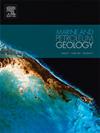Reservoir modeling of heterogeneities, structures, and petrophysical properties of the Berenice Oil Field: Implications for sustainable management and CO2 storage in the North Western Desert, Egypt
IF 3.7
2区 地球科学
Q1 GEOSCIENCES, MULTIDISCIPLINARY
引用次数: 0
Abstract
This study evaluates the CO2 storage potential of the Berenice Oil Field in Egypt's Western Desert using integrated 3D geological and petrophysical modeling. The analysis focuses on the Alam El Bueib AEB-3E formation, a high-quality reservoir with porosity values of 14–16 %, permeability between 10 and 500 mD, and a thick Alamein Dolomite caprock (>100 m), ensuring robust sealing. Seismic interpretation identified structural traps, including tilted fault blocks and horsts, with ENE-WSW and ESE-WNW fault trends forming secure containment structures. Reservoir thickness increases toward the central field, enhancing CO2 storage capacity. The novelty of this study lies in its application of integrated 3D geological and petrophysical modeling to assess CO2 sequestration in a previously underexplored region of Egypt's Western Desert. Petrophysical modeling integrated well log data to evaluate porosity, permeability, shale volume, and water saturation. Spatial analyses using Petrel software identified the central and northwestern regions as optimal storage zones, offering a novel framework for selecting CO2 storage sites based on a combination of structural and petrophysical factors. CO2 storage capacity estimates range from 12.4 million tons (P10) to 146.5 million tons (P90), with a mean of 45.3 million tons. Structural and petrophysical evidence confirms the reservoir's suitability for CCS, addressing key challenges such as caprock integrity and fault stability. By integrating advanced 3D modeling, this study provides a comprehensive, region-specific assessment of the field's storage potential, contributing to Egypt's climate mitigation strategies. These findings validate the use of depleted oil and gas reservoirs (DOGR) for CO2 sequestration and offer a replicable framework for assessing similar reservoirs globally.
Berenice油田非均质性、结构和岩石物理性质的油藏建模:对埃及西北沙漠可持续管理和二氧化碳储存的影响
本研究利用综合三维地质和岩石物理模型对埃及西部沙漠Berenice油田的二氧化碳储存潜力进行了评估。分析的重点是Alam El Bueib AEB-3E地层,这是一个高质量的储层,孔隙度为14 - 16%,渗透率在10 - 500 mD之间,Alamein白云岩盖层厚(>100 m),确保了牢固的密封性。地震解释确定了构造圈闭,包括倾斜的断块和断层体,ENE-WSW和ESE-WNW断层趋势形成了安全的遏制结构。储层厚度向中部增大,增加了CO2的储存量。这项研究的新颖之处在于它应用了综合三维地质和岩石物理模型来评估埃及西部沙漠以前未开发地区的二氧化碳封存。岩石物理建模综合了测井数据来评估孔隙度、渗透率、页岩体积和含水饱和度。利用Petrel软件进行的空间分析将中部和西北部地区确定为最佳储存区,为基于结构和岩石物理因素组合选择二氧化碳储存区提供了一个新的框架。二氧化碳储存能力估计在1240万吨(P10)到1.465亿吨(P90)之间,平均为4530万吨。构造和岩石物理证据证实了储层适合CCS,解决了盖层完整性和断层稳定性等关键挑战。通过集成先进的3D建模,该研究对该油田的储存潜力进行了全面的、针对特定区域的评估,为埃及的气候缓解战略做出了贡献。这些发现验证了耗尽油气储层(DOGR)用于二氧化碳封存的可行性,并为全球类似储层的评估提供了可复制的框架。
本文章由计算机程序翻译,如有差异,请以英文原文为准。
求助全文
约1分钟内获得全文
求助全文
来源期刊

Marine and Petroleum Geology
地学-地球科学综合
CiteScore
8.80
自引率
14.30%
发文量
475
审稿时长
63 days
期刊介绍:
Marine and Petroleum Geology is the pre-eminent international forum for the exchange of multidisciplinary concepts, interpretations and techniques for all concerned with marine and petroleum geology in industry, government and academia. Rapid bimonthly publication allows early communications of papers or short communications to the geoscience community.
Marine and Petroleum Geology is essential reading for geologists, geophysicists and explorationists in industry, government and academia working in the following areas: marine geology; basin analysis and evaluation; organic geochemistry; reserve/resource estimation; seismic stratigraphy; thermal models of basic evolution; sedimentary geology; continental margins; geophysical interpretation; structural geology/tectonics; formation evaluation techniques; well logging.
 求助内容:
求助内容: 应助结果提醒方式:
应助结果提醒方式:


